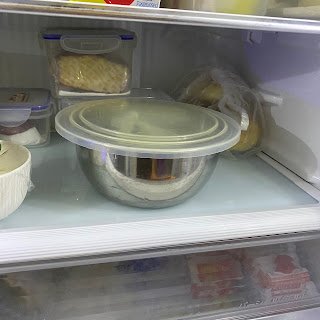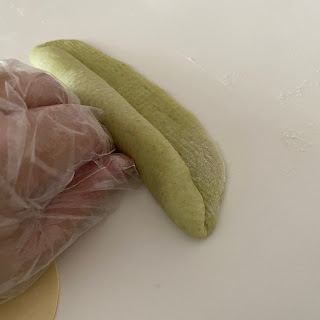Sometimes, I encountered difficulty in namely my bread appropriately. The term, row bun, is a literal translation from the Chinese term 排包. It means buns arranged in row form. And usually the buns are shaped in long rolls.
The pandan flavoured milk buns were topped with icing sugar crust over a thin wash of melted butter before baking. The aroma of the bread was wonderful 😋
Yield: 8 long buns
Equipment: Good hand mixer fitted with dough hooks
Raw dough weight: 398g
Temperature: Preheated oven at 200℃ for 5 minutes, 180℃ for 7 minutes, and 160℃ for 2~3 minutes, at lower rack.
Ingredients
200g unbleached all purpose flour30g raw sugar
7g milk powder
2g instant dry yeast
2g salt, to be added later
30g fresh pandan paste *
20g beaten egg
30g natural yeast/sourdough, 100% hydration ^
20g rice bran oil/mild flavour vegetable oil
50+10g cold water, 10g of water to be added depending on dough moisture
* Blend 20g fresh pandan leaves with 50g water, and collect 30g fresh pandan paste without straining.
^ natural yeast can be replaced by 15g each of all purpose flour and water + 1/8 tsp instant yeast.
Toppings
4g butter, melted
about 1 tbsp icing sugar
Directions
1. Knead bread dough to window pane according to your preferred method.This is my method 😃
Mix all the ingredients, except the salt, together in a mixing bowl, stir in one direction, till the ingredients became a ball.
Cover with a lid and let it stands for about 15 minutes.
After the 15-minutes rest, use a hand mixer fitted with dough hooks, to knead the dough till it becomes smoother *(about 2 minutes at Speed 1). Add in the salt.
Continue to knead at Speed 1 till the dough looks smoother, about 3 to 5 minutes.
Remove the hand mixer, and do about 30 sets of slap-and-folds.
You may like to take a look at the video for the steps, click the link below 😉
Bread dough kneading using a hand mixer
Shape the dough into a ball, cover with a lid, and let it rest for about 60 minutes, or till double in size. Go to Step 2.
OR
After the refrigeration, invert the dough with the bag, and let it thaw for about 50 to 60 minutes.
2. Invert the dough out onto a floured worktop, deflate the dough, and divide into 8 portions, about 50g each.
Shape into a ball,
and place in a plate with lid on. Let the dough rest for about 15 minutes.
While waiting for the dough, melt 4g of butter for use later.
3. Roll flat a dough to about 5mm thick.
Flip over, and roll up from the longer side into a cigar shape.
Pinch to seal.
Place the shaped dough over a baking tray lined with non-stick baking sheet, ensure good spacing between dough.
4. Brush a thin coat of melted butter over the dough.
Let the dough proof in a cold oven for about 45 to 50 minutes, or till the dough double in size.
5. Remove the dough from the oven. Start to preheat the oven to 200℃. Dust a thick coat of icing sugar over the dough.
Bake at lower rack of a preheated oven at 200℃ for 5 minutes, lower to 180℃ for about 7 minutes, and 160℃ for about 2~3 minutes, or till golden.
6. Remove from oven and cool down a while before enjoying 😋

































No comments:
Post a Comment
I love seeing your comment and sharing it with other readers. Your comment would be published after moderation. Thank you :)